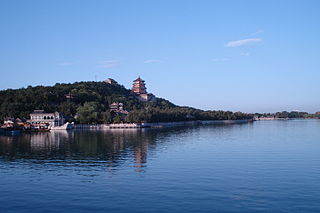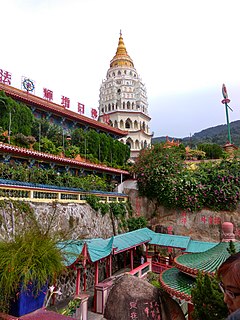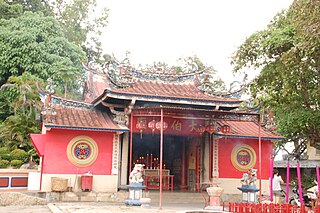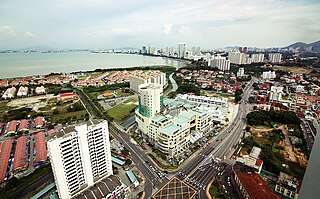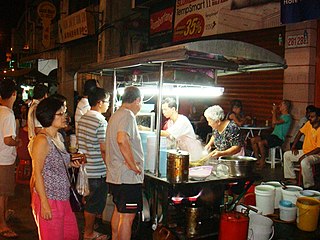| Thni Kong Tnua | |
|---|---|
 | |
| Basic information | |
| Location | Penang Hill, Air Itam, George Town |
| Geographic coordinates | 5°24′35″N100°16′38″E / 5.409697°N 100.277133°E Coordinates: 5°24′35″N100°16′38″E / 5.409697°N 100.277133°E |
| Affiliation | Taoism |
| Deity | Jade Emperor |
| Municipality | Penang Island |
| State | Penang |
| Architectural description | |
| Architectural style | Chinese |
| Completed | 1869 |
| Direction of façade | East |
Thni Kong Tnua, or the Jade Emperor's Pavilion, is a Taoist temple at the foot of Penang Hill at the Air Itam suburb in George Town, Penang. Completed in 1869, it is the only temple in Malaysia to be built specifically for the worship of the Jade Emperor (Hokkien: Thiⁿ-kong) and becomes a focal point for the annual Jade Emperor's Birthday celebrations on the ninth day of Chinese New Year. [1] [2]

The Jade Emperor in Chinese culture, traditional religions and myth is one of the representations of the first god. In Daoist theology he is the assistant of Yuanshi Tianzun, who is one of the Three Pure Ones, the three primordial emanations of the Tao. He is also the Cao Đài of Caodaism known as Ngọc Hoàng Thượng đế. In Buddhist cosmology he is identified with Śakra. In Korean mythology he is known as Haneullim.

Taoism, or Daoism, is a religious or philosophical tradition of Chinese origin which emphasizes living in harmony with the Tao. The Tao is a fundamental idea in most Chinese philosophical schools; in Taoism, however, it denotes the principle that is the source, pattern and substance of everything that exists. Taoism differs from Confucianism by not emphasizing rigid rituals and social order, but is similar in the sense that it is a teaching about the various disciplines for achieving "perfection" by becoming one with the unplanned rhythms of the universe called "the way" or "dao". Taoist ethics vary depending on the particular school, but in general tend to emphasize wu wei, "naturalness", simplicity, spontaneity, and the Three Treasures: 慈 "compassion", 儉 "frugality", and 不敢為天下先 "humility".

Penang Hill is a hill resort comprising a group of peaks on Penang Island, Malaysia. It is located within the Air Itam suburb, 9 km (5.6 mi) west of the center of George Town. Penang Hill is also known by the Malay name Bukit Bendera, which actually refers to Flagstaff Hill, the most developed peak.
The temple, located near the Penang Hill Railway station, was also famously featured in Episode 8 of The Amazing Race 16 .
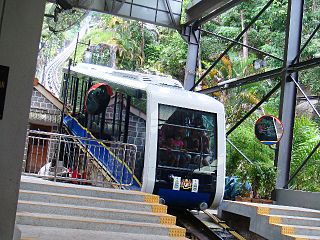
The Penang Hill Railway is a one section funicular railway which climbs the Penang Hill from Air Itam, within the city of George Town in the Malaysian state of Penang. The railway first opened in 1923 as a two-section railway, and the system was overhauled in 2010. The total journey time can take between five and twenty minutes. The funicular train coach travels directly from the lower station to the top, but may stop at other intermediate stations upon request.
The Amazing Race 16 is the sixteenth installment of the American reality television show The Amazing Race. This season featured eleven two-person teams, each with a pre-existing relationship, in a race around the world.
The temple was built in the 1860s by members of the ethnic Chinese Hokkien community in Malaysia and underwent a restoration beginning in 2002. [3] [4]
Overseas Chinese are people of ethnic Chinese birth or descent who reside outside the territories of Mainland China, Hong Kong, Macau and Taiwan. Although a vast majority are Han Chinese, the group represents virtually all ethnic groups in China.

Hokkien or Minnan language (閩南語/闽南语), is a Southern Min Chinese dialect group originating from the Minnan region in the south-eastern part of Fujian Province in Southeastern China, and spoken widely there. It is also spoken widely in Taiwan and by the Chinese diaspora in Malaysia, Singapore, Indonesia, the Philippines and other parts of Southeast Asia, and by other overseas Chinese all over the world. It is the mainstream form of Southern Min.

Malaysia is a country in Southeast Asia. The federal constitutional monarchy consists of 13 states and three federal territories, separated by the South China Sea into two similarly sized regions, Peninsular Malaysia and East Malaysia. Peninsular Malaysia shares a land and maritime border with Thailand in the north and maritime borders with Singapore in the south, Vietnam in the northeast, and Indonesia in the west. East Malaysia shares land and maritime borders with Brunei and Indonesia and a maritime border with the Philippines and Vietnam. Kuala Lumpur is the national capital and largest city while Putrajaya is the seat of federal government. With a population of over 30 million, Malaysia is the world's 44th most populous country. The southernmost point of continental Eurasia, Tanjung Piai, is in Malaysia. In the tropics, Malaysia is one of 17 megadiverse countries, with large numbers of endemic species.




